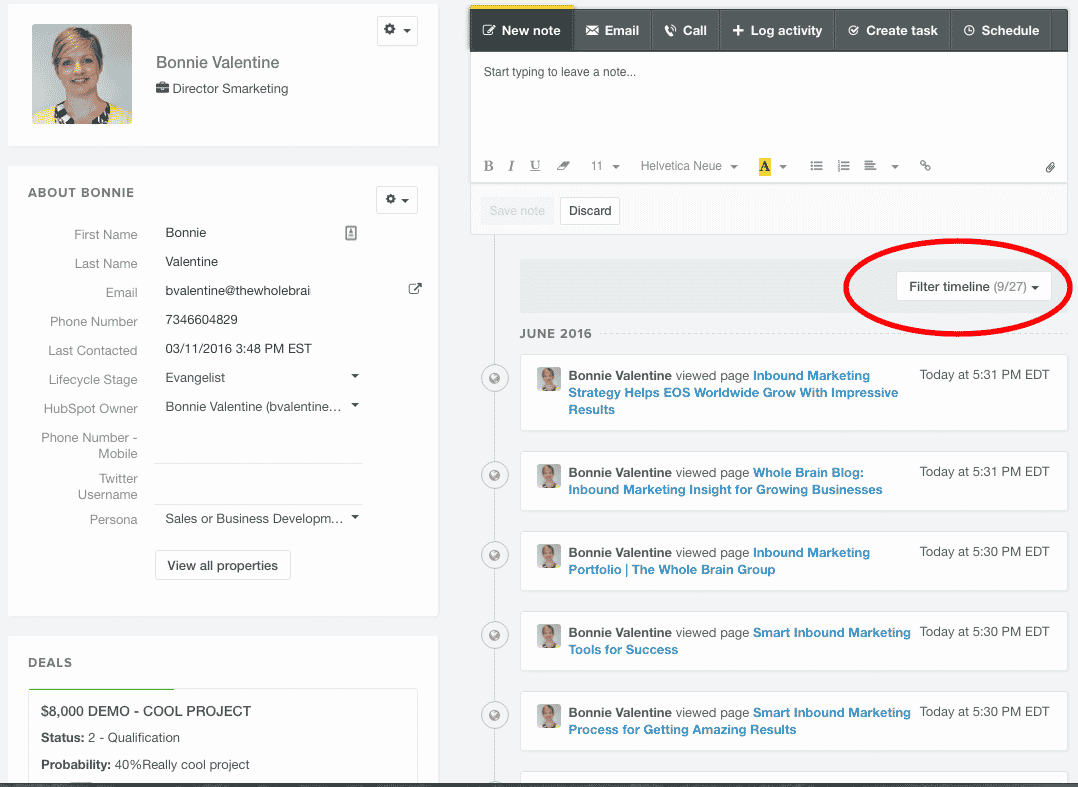
Recently at our Ann Arbor HubSpot User Group mixer, I was asked about the Lead Scoring feature in HubSpot: What’s the optimum lead score?
It’s a good question, because lead scoring is a bit of a mystery to a lot of marketers. How does it work, how do you know what the right numbers are, and what should you be aiming for?
What Is Lead Scoring?
Lead scoring is a way of ranking leads by their likelihood of buying. Lead scoring can be a huge benefit to your sales team because it helps you quickly identify your best qualified leads.
HubSpot marketing automation supports lead scoring by collecting your contacts and automatically scoring them based on their actions and behaviors, level of engagement over a period of time, their profile and demographics, etc. Each behavior has a pre-assigned point value that you have determined. As your contact progresses through the buyer’s journey, their score is updated. Once a contact crosses the lead scoring threshold, they become a qualified lead and your sales team is notified.
Lead scoring is persona-based, so be sure to set up personas in HubSpot, and to include persona fields in your forms, so that each contact gets scored correctly for the right persona.
Improving Your Lead Quality
If you’re like most companies, you’re hearing these most frequent complaints from the sales team about the low quality of leads:
- No defined timeline to make a purchase decision
- Not a decision maker
- No interest in product/service offered
- Not qualified based on agreed criteria
But lead scoring helps guarantee that you’ll always provide a list of highly qualified leads to your sales team.
Assigning Lead Scoring Values
An awesome feature about HubSpot is being able to flip between the marketing side and the CRM sales side of the tool—particularly helpful if you’re trying to figure out the criteria for a good lead.

In the HubSpot CRM, take a look at some successful deals or closed sales. The timeline shares the contact’s history, which might provide you with some obvious signs of what a qualified lead looks like in conjunction with your SLA (link).
You should also speak with your sales team and review closed deals together. This will help you understand their criteria for a serious sales lead and what doesn’t make the cut.
Look for trends. Identify the most common steps that lead to a closed sale and use that to determine the top performing MQL types of conversion points: downloading a white paper, attending a webinar, requesting a demo or quote. Which of those resulted in the highest dollar value in sales revenue?
Assigning Point Values
The point values you assign to each behavior and to your threshold lead score are somewhat arbitrary. They’re based upon a wide range of custom needs.
Begin with identifying the basic criteria that make sense for your business:
- Persona/role and job title
- Company size/number of employees
- Company type/industry
- Geography/location
Score for types of interest:
- Requested a demo or specific information
- Viewed a certain type of product page
- Top-of-the funnel interests (e.g., content downloads like ebooks and webinars) vs. more qualified middle-of-the-funnel interests (e.g., product content like pricing pages or a free trial)
Consider the activity level:
- Number of web pages viewed
- Activities within a specified time period (90 days depending on sales cycle)
- Number of forms completed (content downloaded or inquiries made)
Grant the lead more points to the highest performing activities and behaviors. For example, the persona or job title required might get 20 points and the wrong persona or job title would get negative points. The same goes for your other criteria. Adding up all of the points gets you to your lead score.
After a few months of using lead scoring in HubSpot, go into the data and make some tweaks to fine tune your scoring. Ask these questions:
- Did the top prospects have the best score?
- Does the lead score threshold still hold true?
- Have you added any new marketing activities that need to be assigned a score?
Remember to set up alerts based on your custom lead score to notify your sales team when leads have reached that critical score that makes them sales-ready. Be sure to meet with the sales team monthly to review the results and refine your lead scoring.
Next Steps
- Discover more content to boost sales and marketing.
- Find out how inbound marketing can bring you more qualified prospects.
- Find out how to optimize your sales process—get a free consultation.
Featured image credit: Mr. Littlehand, via Flickr
Still Looking For Answers? We Can Help!
Get the latest news
Blog Topics
- Analytics
- Branding & Identity
- Budget
- Construction
- Content Marketing
- Conversion Rate Optimization
- Email Marketing
- HubSpot
- Inbound Marketing
- Lead Generation
- Marketing Strategy
- News/Events
- Paid Search & PPC
- Recruiting
- Sales & Marketing
- Sales Enablement
- Search Engine Marketing
- Search Engine Optimization
- Social Media
- Thought Leadership
- Uncategorized
- Usability
- Video Marketing
- Web Hosting
- Website Design

